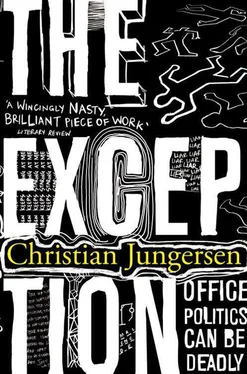Christian Jungersen - The Exception
Здесь есть возможность читать онлайн «Christian Jungersen - The Exception» весь текст электронной книги совершенно бесплатно (целиком полную версию без сокращений). В некоторых случаях можно слушать аудио, скачать через торрент в формате fb2 и присутствует краткое содержание. Год выпуска: 2010, Издательство: Orion Books, Жанр: Современная проза, Триллер, на английском языке. Описание произведения, (предисловие) а так же отзывы посетителей доступны на портале библиотеки ЛибКат.
- Название:The Exception
- Автор:
- Издательство:Orion Books
- Жанр:
- Год:2010
- ISBN:нет данных
- Рейтинг книги:3 / 5. Голосов: 1
-
Избранное:Добавить в избранное
- Отзывы:
-
Ваша оценка:
- 60
- 1
- 2
- 3
- 4
- 5
The Exception: краткое содержание, описание и аннотация
Предлагаем к чтению аннотацию, описание, краткое содержание или предисловие (зависит от того, что написал сам автор книги «The Exception»). Если вы не нашли необходимую информацию о книге — напишите в комментариях, мы постараемся отыскать её.
The Exception — читать онлайн бесплатно полную книгу (весь текст) целиком
Ниже представлен текст книги, разбитый по страницам. Система сохранения места последней прочитанной страницы, позволяет с удобством читать онлайн бесплатно книгу «The Exception», без необходимости каждый раз заново искать на чём Вы остановились. Поставьте закладку, и сможете в любой момент перейти на страницу, на которой закончили чтение.
Интервал:
Закладка:
Roles shape people
In 1971 the social psychologist Phillip G. Zimbardo and some of his colleagues at Stanford University decided to investigate the psychological consequences of the relationship between a prisoner and a prison guard.
They advertised for student subjects, stating that they needed twenty-one males, who would be paid for the two-week experiment. All applicants were interviewed, but only those who seemed reasonably stable, mature and responsible were picked. They were then randomly divided into two groups: prisoners and guards.
On day one, real policemen came to the homes of ten of the participants and ‘arrested’ them ‘on suspicion’ of break-ins and armed robbery. They were taken to a university basement corridor that had been made to look like a prison and were ordered to undress, be deloused and put on prison overalls. The designated ‘guards’ were dressed in uniforms, complete with mirrored sunglasses and truncheons.
The guards were called to a meeting and told to keep the prisoners under surveillance, but not to hurt them physically. The prisoners stayed in the prison round the clock, while the guards went home to their normal lives after an eight-hour working day.
In the beginning of what became known as the Stanford Prison Experiment, there were no significant personality differences between randomly picked guards and prisoners. Later, both groups were to change remarkably quickly.
The absolute power given to the guards made the prisoners helpless and submissive, enabling the guards to extend their powers still further. This mutual interaction was the start of a self-reinforcing, damaging process.
A third of the guards behaved with increasing callousness and in an arbitrary manner, initiating punishments for no reason and devising inventive means of humiliating the prisoners. In their ordinary lives they had shown no tendencies to aggressive or tyrannical behaviour.
Two of the guards went out of their way to support the prisoners, but never came close to publicly confronting the hostile guards. The rest of the guards were tough, but did not initiate any unofficial punishments.
The prisoners became depressed, despairing and passive. Three of them had to be ‘freed’ only four days into the experiment, because they wept hysterically, lost the ability to think coherently and became deeply depressed. A fourth prisoner was released after getting a rash that covered his entire body.
All but three of the prisoners were willing to forgo payment for the days they had spent on the experiment if they could be let out. When they were told that their pleas for ‘parole’ had been turned down, they passively and obediently plodded along back to their cells.
The Stanford Prison Experiment demonstrates that prisoners and guards acted according to the roles given to them by an external agent, gradually changing their thought patterns, values and emotional responses to fit in. Most of the participants seemed unable to make a distinction between their real selves and their role in the experiment. Prison brutality escalated with each successive day. Ordinary moral values vanished, despite the fact that each group was determined indiscriminately.
The experiment had to be interrupted after six days, mainly because the remaining prisoners were unacceptably close to mental breakdown.
There are of course many other contexts in which the role and the self become contiguous. As James Waller says in his book entitled Becoming Evil (parts of this account are based on his analysis of the existing evidence): ‘Evil acts not only reflect the self, they shape the self.’
Groups formed for almost no reason
The English social psychologist Henri Tajfel and a few of his colleagues set out to study how many features people must have in common in order to see themselves as part of a group and, as a next step, set up a system of prejudices against other groups.
His first plan was to recruit people without any regard to common features, allocate them at random to groups and then gradually introduce similarities, negative prejudices and conflicts between the groups. He expected that this process would allow him to observe how and when group identity is formed.
In his best-known ‘minimal group’ experiment, he asked the subjects to express their opinions of a few abstract paintings and separated them afterwards into two groups. One lot were told that they had all expressed a preference for paintings similar to those by Paul Klee, while the others preferred the style of Wassily Kandinsky. None of this was true, as group allocation was entirely random.
The subjects did not know each other and had had no prior contact. Given the opportunity to evaluate photographs of all the subjects, participants ranked those in their own group as better at their jobs and more pleasant to be with. When individuals were asked to distribute money, group members were always favoured.
In a similar experiment some of the subjects were so biased against the other group that they were happier for their own people to receive $2 rather than three, on condition that the others received $1 instead of four. In other words, they were more interested in ‘beating the others’ than getting the highest possible payment for their own members.
Until this series of experiments, most social psychologists had assumed that group identity was created gradually in response to shared experiences. Nobody expected prejudice and hostility to emerge between people without any knowledge of their own group or of the others.
Relationships within a group, or between groups, constitute classical fields of research in social psychology. Many different experiments show that our thoughts operate according to an ‘Us-and-Them’ model. The basis for this is straightforward. Everyone is forced to work out how to deal with a world that is endlessly complex. In order to simplify existence and sort out irrelevant information quickly, we divide ourselves into categories.
Categorisation is a human way of thinking, as essential as it is unavoidable. Types of category vary between individuals and cultures, but the process is common to us all. It shapes how we understand our environment and our relationship to it.
Social psychology has demonstrated some of the consistent distortions caused by the Us-and-Them model. We tend to exaggerate the similarities of those who belong to our group, just as we exaggerate the homogeneity in other groups and the differences among them. And normally, we care more for members of our own group than for others.
In crises or open conflicts these attitudes become extreme. All mankind has the potential for believing the propaganda machine when it repeats endlessly: ‘Kill, or be killed!’
The victim asks for it
We are all aware that good people are not immune from bad experiences, but a large majority of us nonetheless try to hold on to the hope of a fundamentally just world, a good place to bring your children into.
As numerous studies demonstrate, this hope, combined with the barely conscious human need for meaning and for coherence in the information we receive, makes us twist reality until it fits into our vision of order.
It is not only those who carry out terrible acts who are deluded by their distorted thought patterns, memories and sensory input into believing that their world is still just and meaningful. Those who witness the tragedies and, indeed, the victims themselves also collaborate in this fiction.
People struck down by a serious illness, as well as those close to the patient, are often determined to find the cause. They feel a strong need to establish exactly what they have done wrong to deserve the affliction. Again, it is common for victims of violence to wonder about the root cause. ‘Maybe I asked for it; maybe I shouldn’t have walked down that lane so late at night; maybe I shouldn’t have worn that dress.’ Such anxieties become the focus of their thoughts, regardless of the fact that they have the right to walk down any lane and wear any knd of clothes.
Читать дальшеИнтервал:
Закладка:
Похожие книги на «The Exception»
Представляем Вашему вниманию похожие книги на «The Exception» списком для выбора. Мы отобрали схожую по названию и смыслу литературу в надежде предоставить читателям больше вариантов отыскать новые, интересные, ещё непрочитанные произведения.
Обсуждение, отзывы о книге «The Exception» и просто собственные мнения читателей. Оставьте ваши комментарии, напишите, что Вы думаете о произведении, его смысле или главных героях. Укажите что конкретно понравилось, а что нет, и почему Вы так считаете.












